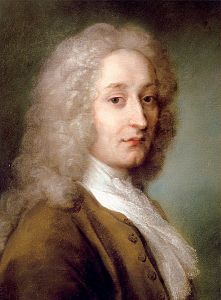
|
Watteau was born on October 10, 1684, in Valenciennes, a Flemish town that had become French shortly before his birth. At the age of 14 he began to study under an obscure painter of religious subjects in his native town. In 1702 he went to Paris, where he eked out a living as a painter for a dealer in cheap devotional pictures. He later studied under the French engraver and stage designer Claude Gillot, from whom he gained an interest in the character of the fashionable Italian commedia dell'arte.
About 1708 Watteau began to work with the decorative artist Claude Audran, curator of the Luxembourg Palace collections. There he had an opportunity to study a great series of baroque paintings by the Flemish master Peter Paul Rubens. In 1709 Watteau placed second in the competition for the Prix de Rome and thereafter received many important commissions. Named an associate of the French Academy in Paris in 1712, he was elected to full membership in 1717. Watteau, who had a frail constitution and was often ill, succumbed to tuberculosis. He died in Nogent-sur-Marne on July 18, 1721.
Watteau's canvases reflect the influence of the great Flemish painters, particularly Rubens, and of the Venetian school of painting. His own distinctive style, however, demonstrated a feeling for light and color and offered a delicate sensuousness and lyric grace that had been previously unexplored. Other rococo painters imitated Watteau's style, but they failed to achieve the dreamlike quality of his paintings. Watteau's reputation declined with the rise of neoclassicism in French art, but after the French Revolution, and especially in the romantic period, it rose again.
Among Watteau's favorite subjects were fashionable outdoor gatherings, known as fËtes galantes (French, "scenes of gallantry"), in which elegant court ladies and gentlemen pass their time in pleasant dalliance among trees and shrubbery. His masterpiece in this category is L'Embarquement pour l'ïle de CythÉre (1717, Musée du Louvre, Paris). Another favorite subject was clowns, harlequins, and other figures from the commedia dell'arte, such as Harlequin and Columbine (1715, Wallace Collection, London) and The Italian Comedians (probably 1720), National Gallery of Art, Washington, D.C.. L'Enseigne de Gersaint (1720, Staatliche Museen, Berlin), a signboard painted for the shop of an art dealer and friend of Watteau, is a masterpiece of genre realism in its composition and drawing. Its use of color influenced 19th-century impressionism.
|
